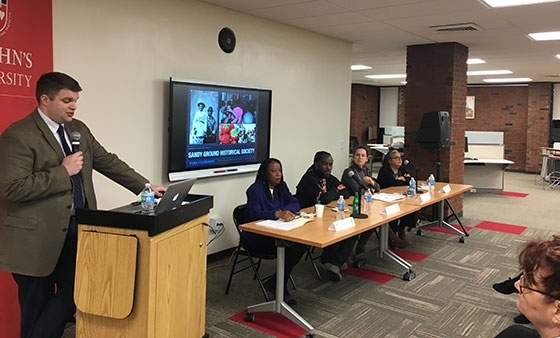
St. John’s University’s Staten Island campus held the last of its “Sandy Ground at St. John's: Faces of the Underground Railroad” events on December 12 with a presentation on the historic role Brooklyn’s African-American community played in revitalizing Bedford-Stuyvesant and the impact of history, arts, and culture on the fast-paced redevelopment of Staten Island’s North Shore. “Sandy Ground’s Past and Staten Island’s Future: A Colloquium on Arts, Education, and Historically Informed Community Development,” was the fourth in a lecture series sponsored by the New York Council for the Humanities.
Tia Powell Harris, Executive Director of Weeksville Heritage Center, shared the history and vision of Bedford-Stuyvesant’s Weeksville Heritage Center, and Jason Bartlett, Ph.D., Assistant Director of Student Life and Residence Life at St. John’s University’s Staten Island campus, provided historical context and commentary on African-American activist traditions and the formation of the Bedford Stuyvesant Restoration Corporation, the first community development corporation. A panel of Staten Island cultural leaders, including Sylvia D'Allessandro, Executive Director, Sandy Ground Historical Society and Museum; Bobby Digi, Founder and Executive Director of the CANVAS Institute and Island Voice; Diane Matyas, Vice President of Exhibition and Programs, Staten Island Museum; and Kelly Vilar, Founder, Staten Island Urban Center and Maritime Educational and Recreational Corridor (MERC), then discussed the future of their cultural and community-building efforts in light of the redevelopment of Staten Island’s North Shore, where the St. John’s campus is located. While looking forward, panelists and audience members embraced the example of Weeksville Heritage Center and Sandy Ground Historical Society and Museum as inspiration and a historical guide for more inclusive and participatory urban development.
Robert Fanuzzi, Ph.D., Associate Provost for Academic Affairs, Director of Civic Engagement and Public Programs, Office of the Vice Provost, Staten Island campus, and Director of the Sandy Ground at St. John’s program, said that this event helped the audience and University community recognize that “arts, culture, and history matter—not just to individuals, but to the future of neighborhoods and the creation of common spaces.” African-American history and art, he noted, has played a powerful role in cities’ community-driven urban development strategies.
Sandy Ground at St. John’s has been a public humanities and educational outreach program on St. John’s University’s Staten Island campus, in partnership with the Sandy Ground Historical Society. High school visits to the exhibit, “Faces of the Underground Railroad,” will continue through March.
Related News
Alumna Celebrates Book Launch After Career Change
After developing a passion for helping the younger generation, Ashley Wilson ’14M.S.Ed. pivoted from a career in the music industry to work as an educator. She is also making her mark through her new...
Dean Jerrold Ross Conference Room Unveiled
On Tuesday, December 10, the newly renovated conference room on the fifth floor of Sullivan Hall was dedicated in honor of Jerrold Ross, Ph.D., former Dean of The School of Education . The renovation...
Institute for Catholic Schools Provides Educational Resources to Local Catholic School
The Institute for Catholic Schools (ICS) in The School of Education at St. John’s University recently donated approximately $2,800 worth of academic and sensory learning tools to Father Vincent...
